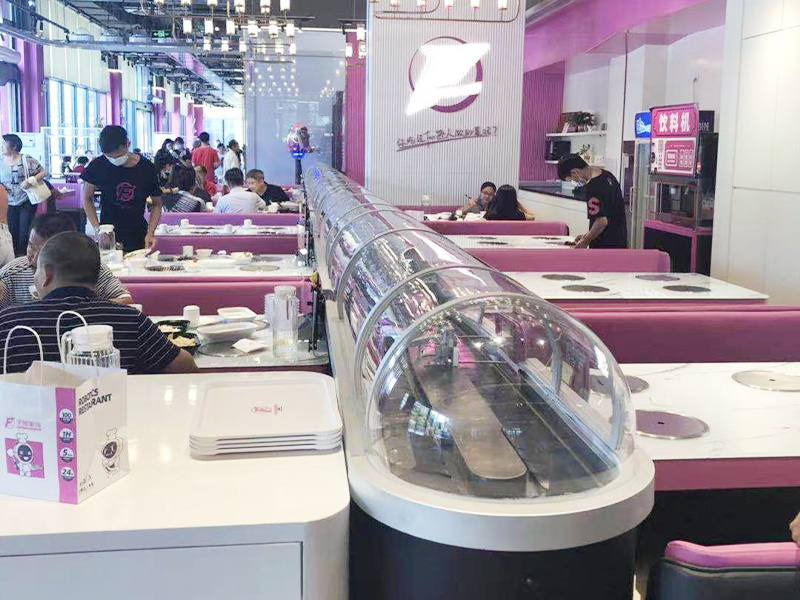Efficient Solutions for Sushi Food Delivery Trains in the Food Transport Sector
Release Time:2025-07-10
---
In the ever-evolving world of food delivery, particularly for delicate items like sushi, the integration of specialized food storage and transport equipment is paramount. Sushi food delivery trains are designed to maintain the freshness and quality of sushi while navigating through various logistical challenges. This article delves into the essential aspects of sushi food delivery trains, highlighting the importance of proper equipment and strategies for successful operations.
One of the key factors in sushi delivery is temperature control. Sushi, being a raw food item, requires strict adherence to temperature regulations to prevent spoilage and ensure food safety. Utilizing advanced food storage equipment that features precise temperature controls can significantly enhance the quality of sushi during transport. For instance, refrigeration units with adjustable settings allow operators to tailor the environment to suit the specific needs of sushi, preserving its delicate flavors and textures.
Moreover, the design of sushi food delivery trains should prioritize ease of access and efficient loading/unloading processes. Streamlined workflows are critical in minimizing the time sushi spends in transit, which directly impacts its freshness. Investing in user-friendly containers that facilitate quick access can improve operational efficiency, ultimately benefiting the customer experience.
Hygiene is another crucial consideration in the transport of sushi. Food delivery trains must be constructed from materials that are easy to clean and maintain. Implementing practices that adhere to food safety standards will help prevent contamination and ensure that sushi reaches customers in optimal condition. Regular inspection and maintenance of storage equipment are vital to upholding these standards.
In addition to temperature and hygiene, the capacity and layout of sushi food delivery trains are also important. The design should maximize the available space while ensuring that sushi is securely packaged to prevent damage during transit. Utilizing compartmentalized containers can help keep different types of sushi separate, reducing the risk of cross-contamination and preserving the integrity of each item.
Furthermore, as the demand for sushi continues to rise, businesses must remain adaptable. Implementing technology such as tracking systems can provide real-time monitoring of delivery conditions, ensuring that any temperature fluctuations are promptly addressed. This proactive approach can significantly enhance reliability and customer satisfaction.
In conclusion, the seamless operation of sushi food delivery trains hinges on the effectiveness of food storage and transport equipment. By focusing on temperature control, hygiene, efficient design, and technology integration, businesses can elevate their sushi delivery services. Investing in these aspects not only ensures the quality and safety of sushi but also enhances overall operational efficiency, setting the stage for success in the competitive food delivery landscape.
In the ever-evolving world of food delivery, particularly for delicate items like sushi, the integration of specialized food storage and transport equipment is paramount. Sushi food delivery trains are designed to maintain the freshness and quality of sushi while navigating through various logistical challenges. This article delves into the essential aspects of sushi food delivery trains, highlighting the importance of proper equipment and strategies for successful operations.
One of the key factors in sushi delivery is temperature control. Sushi, being a raw food item, requires strict adherence to temperature regulations to prevent spoilage and ensure food safety. Utilizing advanced food storage equipment that features precise temperature controls can significantly enhance the quality of sushi during transport. For instance, refrigeration units with adjustable settings allow operators to tailor the environment to suit the specific needs of sushi, preserving its delicate flavors and textures.
Moreover, the design of sushi food delivery trains should prioritize ease of access and efficient loading/unloading processes. Streamlined workflows are critical in minimizing the time sushi spends in transit, which directly impacts its freshness. Investing in user-friendly containers that facilitate quick access can improve operational efficiency, ultimately benefiting the customer experience.
Hygiene is another crucial consideration in the transport of sushi. Food delivery trains must be constructed from materials that are easy to clean and maintain. Implementing practices that adhere to food safety standards will help prevent contamination and ensure that sushi reaches customers in optimal condition. Regular inspection and maintenance of storage equipment are vital to upholding these standards.
In addition to temperature and hygiene, the capacity and layout of sushi food delivery trains are also important. The design should maximize the available space while ensuring that sushi is securely packaged to prevent damage during transit. Utilizing compartmentalized containers can help keep different types of sushi separate, reducing the risk of cross-contamination and preserving the integrity of each item.
Furthermore, as the demand for sushi continues to rise, businesses must remain adaptable. Implementing technology such as tracking systems can provide real-time monitoring of delivery conditions, ensuring that any temperature fluctuations are promptly addressed. This proactive approach can significantly enhance reliability and customer satisfaction.
In conclusion, the seamless operation of sushi food delivery trains hinges on the effectiveness of food storage and transport equipment. By focusing on temperature control, hygiene, efficient design, and technology integration, businesses can elevate their sushi delivery services. Investing in these aspects not only ensures the quality and safety of sushi but also enhances overall operational efficiency, setting the stage for success in the competitive food delivery landscape.
Keywords:Sushi Food Delivery Trains
CATEGORY
Related News
2024-02-03
Related










